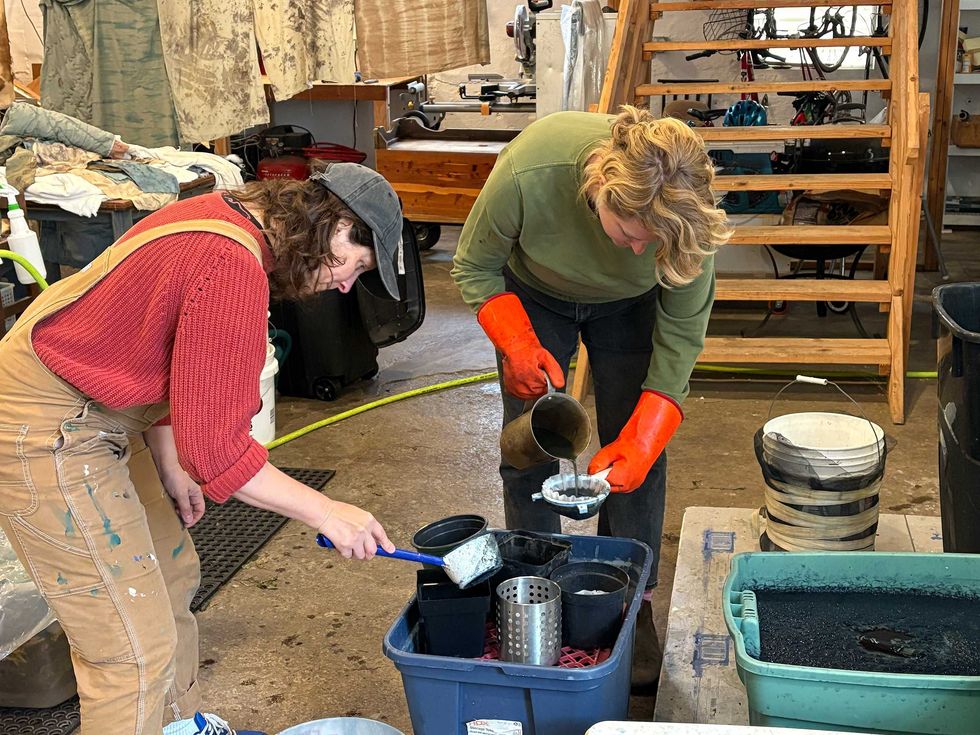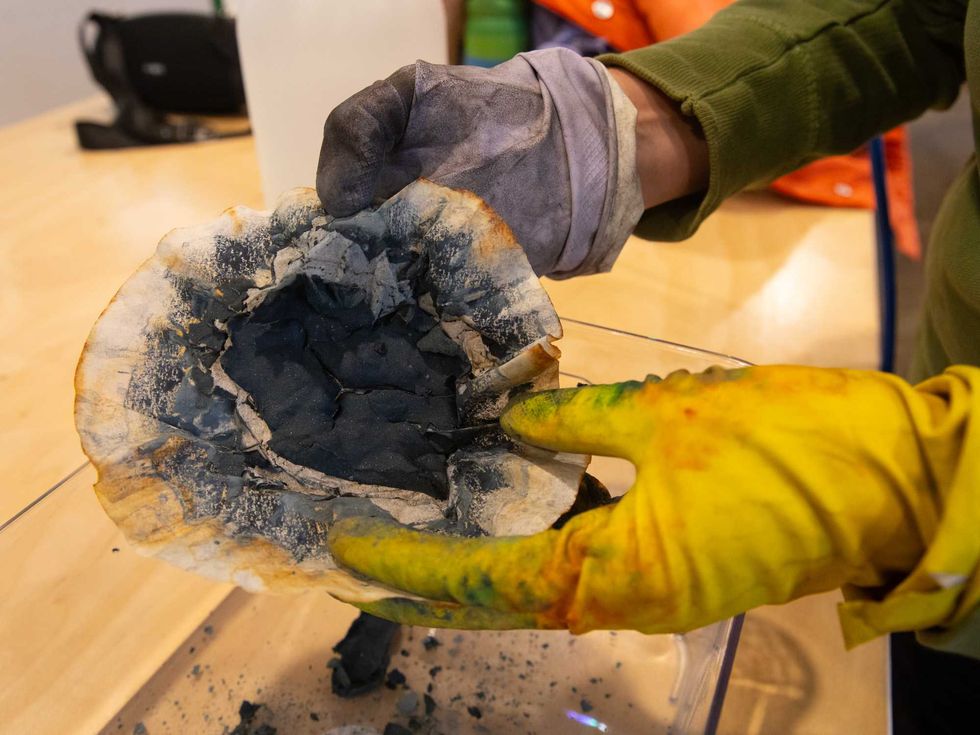Indigo girls: a collaboration in process and pigment

Artist Christy Gast
Photo by Natalie Baxter

Artist Christy Gast
In Amenia this fall, three artists came together to experiment with an ancient process — extracting blue pigment from freshly harvested Japanese indigo. What began as a simple offer from a Massachusetts farmer to share her surplus crop became a collaborative exploration of chemistry, ecology and the art of making by hand.
“Collaboration is part of our DNA as people who work with textiles,” said Amenia-based artist Christy Gast as she welcomed me into her vast studio. “The whole history of every part of textile production has to do with cooperation and collaboration,” she continued.
That sense of shared purpose is at the heart of the invitation Gast extended to artists Natalie Baxter and Janis Stemmermann to process a bumper crop of Japanese indigo (Persicaria tinctoria) at her studio this fall. All three artists’ practices intersect through material, process and an interest in the handmade. Gast and Stemmermann have collaborated on a series of hand-knit vests dyed with black walnut, available through Stemmermann’s store, Russell Janis. Baxter is a Wassaic Project residency and fellowship alum, who is leading a community quilting workshop there on Nov. 15. She also co-directs “Cottage Courses” with artist Polly Shindler, a series of hands-on artmaking workshops throughout the region.
“Lisa Dachinger of Hilltop Farm & Fiber Arts north of Pittsfield, Massachusetts had an abundance of indigo this year,” said Gast of her learning about the crop’s availability.In two trips to the farm, Gast harvested the plants and began experimenting with the ancient art and science of extracting pigment from the plants and transforming it into rich, layered blues.

“There are a lot of steps,” Gast noted with a laugh, as vats of aerated indigo bubbled in the corner of the studio. The process is slow and physical, dependent on timing, temperature and a kind of faith in chemistry. The freshly harvested Japanese indigo leaves are first soaked in warm water and left to ferment for several days. The plant matter is then removed, the solution is strained and the pH is raised with the addition of calcium hydroxide, and then the mixture is aerated, poured back and forth between containers until it oxidizes and the pigment turns dark blue. After the indigo settles to the bottom, the resulting paste is filtered, dried and ground into powder. Only then is it ready for dyeing.
But as Stemmermann pointed out, “It’s not a dye. It’s a coating and reaction.” Indigo’s elusive chemistry means each piece is unpredictable, shaped as much by chance as by control. To achieve a deep, saturated blue, “you have to layer it and dip it up to eight times,” she explained.
Each artist uses dye in their work, albeit quite differently, yet all share a deep sensitivity to material and process. “There is a seasonality to textile work,” said Baxter, referring to dye plants.“First, there’s the planting. And then you wait for them to grow, you harvest them, you dye the fabric and then it’s wintertime.” During quilt season when our attention turns inward, the patient, hands-on process becomes a meditation on slowness for Baxter, mirroring the rhythm of the earth and a quiet longing to move with it.

For Gast, working with plant dyes is a way to align artistic practice with ecology and activism. “I’m working on a project that will be showing at Mass MoCA in 2027,” she explained. “It’s a collaborative opera about peatlands for which I’m producing a textile installation that functions as the curtains. I’m using as many natural and regional processes as possible because our work has to do with local-to-global activism and conservation. There is a chemical alchemy in peatlands, which despite covering just 3% of the Earth’s surface, capture more than twice the carbon of all the planet’s forests combined. There’s a direct poetic alignment between plant dye processes and peatlands, which preserved some of the earliest textiles we know of. And the color palette is ancient, both familiar and uncanny.”
There’s a certain chaos in balancing experimentation with intent. For Gast, Baxter, and Stemmermann, this first attempt at pigment extraction has been as much about curiosity as outcome, a communal act of making, rooted in patience, experimentation and discovery.
To find out more about these artists, visit: christygast.com, nataliebaxter.com and janisstemmermann.com
The Community Closet at HVRHS is open for students to take clothes for any reason during the school day.
What started with one unexpected donation of clothes has grown into a quietly impactful resource for all students at HVRHS: the Community Closet. Now located in a spacious area above the cafeteria, the closet offers free clothing to any student for any reason.
The idea began a few years ago when a community member reached out to the former superintendent wondering if anyone at the school could benefit from used clothing that would otherwise go to waste. The superintendent then got in contact with Rachel Novak, the school social worker. “Once I had all those bags of clothes in my room, I was like, ‘I should put this in a space,’” Novak said. Her simple idea eventually became a full-sized closet accessible to all students.
From the beginning, Novak envisioned the closet as an inclusive space. “It’s open to anybody, it’s not just based on economic needs,” she said. Sustainability also plays a role. “Thinking about the environment, some students like to thrift and just get clothes that way,” Novak said.
After the initial donation, contributions continued to grow. “I reached out to our staff members and faculty,” Novak said. The most consistent donations come from the faculty at HVRHS and a few community members who learned about the closet. Finding teenage-appropriate clothes has been a challenge. “I get a lot of donations that are nice, but I don’t think teenagers would want to wear them,” Novak said.
Another ongoing obstacle has been awareness. Many students don’t know the closet exists at all. “That’s been the hard part,” Novak said. “Getting it out to the wider community of the school.” Novak is looking for students and staff to spread the word. “It helps because our school nurse knows and other faculty members,” she said. “When they know a student needs something, they just bring them up.”
Looking ahead, she hopes to promote the space more actively. “When we come back from this break, I do plan to … get fliers and all that up and going,” Novak said. There may even be an upcoming expansion — she has discussed the possibility of turning part of the area into a food pantry. “That would be more of a need-based system for students,” she said. “But right now, promoting it is where I’m at.”
The Community Closet is well-stocked currently. “Just because of the amount of clothes I have, I’m not accepting any more donations until I clear some stuff out,” Novak said. She is still willing to make room for more fashionable, teen-friendly items donated by students. “That way I’ll have more teenager approved clothes.”
Above all, she wants students to know that no one is limited to using the space. “Sometimes there’s a stigma around it … like, ‘I don’t need help. I don’t want to take away from anybody else that may need it,’” Novak said. Due to the amount of clothes, students should feel welcome to use the closet for any reason. Some students even grab items last minute for sports and activities. “It’s important for kids to know it’s for everyone.”
Whether a student wants to thrift clothes sustainably, forgot to pack clothes for an after-school practice, or is in need of a new outfit, the Community Closet is a resource for all.
Sophomore Eliana Lang enjoys her Housy Shack cookie.
Now in its second year, the Housy Shack is a hit among students. The special education department-run store that sells warm cookies, drinks and other snacks to students and teachers draws people to a room in the back hallway every time it’s open.
The smell of warm cookies welcomes visitors to the store with snacks, drinks and even Housy merchandise for sale. The cookies are definitely the favorite, sometimes lines go out the door to get one before they sell out.
The cookies are so popular that the store had to increase prices from 50 cents to a dollar and implement a four cookie per person maximum. The Shack sells about 40-100 cookies per day and has about 20-60 HVRHS customers visiting per day.
Julie Browning and Heather Strid, two of the HVRHS faculty members that help run the Shack, said their goal was to create real-world job experiences as well as real-world shopping experiences for students at HVRHS. “Learning the skills to work in the world can be taught in a classroom, but the lessons are more meaningful and valuable when they are applied in real work situations, which is what we create through the school store,” Browning said.
The original purpose for the store seems to be working, as several students are learning important skills. Students said the store taught them skills like counting money, checking inventory and cleanliness along with social skills and customer service that could help in the professional world after high school.

As the store quickly became a hit, organizers were faced with the challenge of finding funding. “When we started planning to start the school store two years ago we needed money to buy equipment, supplies and food to start it up but were not sure how to get it,” Browning said. “Mrs. Strid came up with the idea of applying for a grant from the 21st Century Fund to help us get started and they were so generous.” That grant has been crucial to the success and growth of the school store.
Not only does the Housy Shack benefit the special education department, students said it fosters a sense of community throughout the school. “School store cookies are my favorite thing ever. They brighten up my day,” said Eliana Lang, a sophomore at HVRHS. Dayana, one of the student staffers at the Housy Shack, said her favorite part of working in the school store is when students come in to make purchases. She enjoys talking to them and ringing up their orders on the cash register. The Housy Shack brings people together and offers the opportunity for students to connect with each other.
As the school year continues, the members of the school store look forward to expanding their inventory by creating and selling a variety of Housy merchandise — t-shirts, sweatshirts, water bottles, and more. “I have had several students put in requests for certain hats, key chains, etc. … so there will be more of that to come,” Browning said. Last school year, profits were all invested back into the school store. “This year we are hoping to make more of a profit and will look to use the money that we make for field trips, outings as well as opportunities to donate and give back to the community,” Browning said. They also would like to use the school store to fundraise for other causes. “Right now we are collecting donations for The Little Guild Animal Shelter, so if anyone has pet supplies they would like to donate please drop them off in exchange for a cookie,” Browning said.